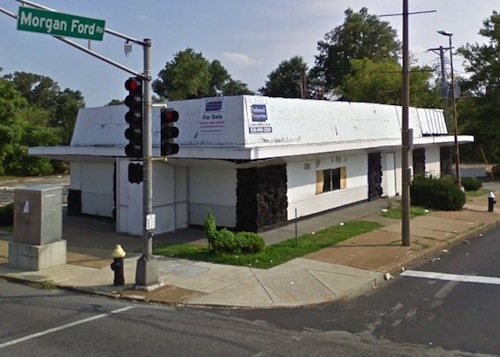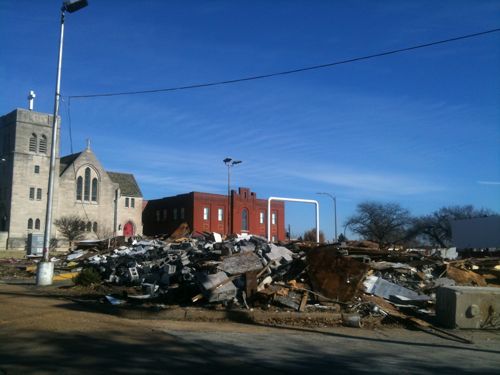Vacant Fast Food Structure at Chippewa & Morgan Ford Razed

Since 1964 the building shown above has sat on the SE corner of Chippewa & Morgan Ford (4298 Chippewa) in South St. Louis. Â The first 40 years it was a Steak & Shake location, until a larger location to the west at 4644 Chippewa opened in 2004. The old location has been vacant the last six years.

The old building was 2,098 square feet on a 22,1887sf lot whereas the 2004 location is 3,840sf on a 38,246sf parcel, substantially larger in both the building size and total land area.
Curious about future plans for the site I contacted the property owner, Ryann Spencer Group, in High Ridge MO, but my calls were not returned.
– Steve Patterson
Will there be anyone to cry foul at the destruction of this iconic mid-century structure? Anyone to demand maintaining this building's integrity until a new use can be found?
My hunch is that there is concensus this old restaurant should be removed from our streetscape.
I could be wrong. Someone submit why buildings like this should be saved from teh bulldozer.
Actually, the one at 1300 Lemay Ferry Road is more iconic and deserving of preservation . . . http://maps.google.com/maps?f=…
Why?
Ahh, the classic issue in historic preservation, personal preference combined with context. This structure (on Chippewa) was definitely out of character with the surrounding neighborhood and was a fairly generic design for its time, copying similar architecture that originated in southern California. The one on Lemay Ferry is older, in context with its surroundings and one that I simply like more. It's not much different than the arguments over preserving Victorian architecture over Richardsonian, Prairie Style versus Georgian. Styles change and fall in and out of favor, and as a child of the '50's, there's a certain comfort with the familiar architecture of my youth.
There's a lot to be said for trying to save good examples of every kind, as well as trying to save the feel of intact neighborhoods, but this all needs to be balanced with the reality that buildings need to be used to justify the costs of their ongoing maintenance. The demolished structure obviously met neither criteria – no viable use and no champion of its style – so it was removed. Will we, as a community, lament its loss in 10 or 20 years? Will whatever replaces it be “better”, a real improvement? Who knows? Only time will really tell.
And the larger issue remains who's the ultimate decider, the government, through the rule of the majority and the professed expertise of its employees and its elected members, or the property owner, who's risking their own money? I'm guessing here that the owners had hoped to find a viable use for their investment, but that pressure from the city to keep the structure maintained and secure reached the point where it was cheaper to just tear it down, minimize their ongoing liability, and to try and market the vacant lot, instead. Unfortunately, this equation is being played out over and over across the city, driven by declines in population, jobs and income, and little is coming back to refill these “opportunities”.
^ I doubt anyone thinks they should. They are built cheaply, use the land inefficiently, and have zero artistic merit. At best they invoke a sense of nostalgia for the post-war years when the U.S. was prospering and the “freedom” of the open road was still novel.
I'm also concerned as to what will happen with this land. I mean, the nearest Quick Trip is at least 3 or 4 blocks away, right? This intersection may not be quite vital enough to warrant their devastation – it seems they like to ruin as much neighborhood as possible per station (even if it means just erecting a station and then letting it sit abandoned and opening a larger one down the street.)
anyway, this would be a great opportunity to book-end Morganford with some urban residential and work North toward connecting to the Tower Grove end.
but then again… High Ridge… *sigh*
oops. i always forget the new comments post ABOVE the old comments. that “^” should be pointing down as i was trying to refer to RobbyD's comment.
^ I doubt anyone thinks they should. They are built cheaply, use the land inefficiently, and have zero artistic merit. At best they invoke a sense of nostalgia for the post-war years when the U.S. was prospering and the “freedom” of the open road was still novel.
I’m also concerned as to what will happen with this land. I mean, the nearest Quick Trip is at least 3 or 4 blocks away, right? This intersection may not be quite vital enough to warrant their devastation – it seems they like to ruin as much neighborhood as possible per station (even if it means just erecting a station and then letting it sit abandoned and opening a larger one down the street.)
anyway, this would be a great opportunity to book-end Morganford with some urban residential and work North toward connecting to the Tower Grove end.
but then again… High Ridge… *sigh*
similar case in Portland, only there's plans for a replacement: http://www.oregonlive.com/port…
hasn't the old one been closed longer than since 2004? i moved to st. Louis in 2002, and i thought it had been closed since then. and wasn't there a fire at the old location that prompted it's premature closure prior to the new one opening?
Two weeks later, the site looks virtually the same (a pile of rubble) – what's up with that? Shouldn't the demolition work be complete by now, leaving a safe, level site?
There was a bulldozer on site late last week picking up debris. Does a demo company generally have a time limit on its permit?
I have no idea on the permit, but most larger, reputable (“licensed and bonded”) demo contractors I'm familiar with want to get in and get out quickly, probably within one day, and no more than two or three. There's just too much liability having unstable, sharp piles of debris left open to the public. The only two reasons/excuses I can see here are limited resources or intensive recycling.